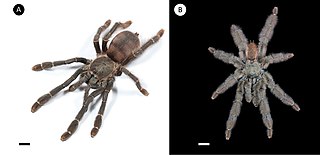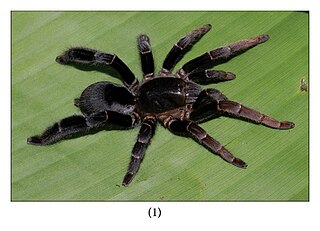
The Goliath birdeater belongs to the tarantula family Theraphosidae. Found in northern South America, it is the largest spider in the world by mass and body length, and second to the giant huntsman spider by leg span. It is also called the Goliath tarantula or Goliath bird-eating spider; the practice of calling theraphosids "bird-eating" derives from an early 18th-century copper engraving by Maria Sibylla Merian that shows one eating a hummingbird. Despite the spider's name, it rarely preys on birds.

The Brazilian whiteknee tarantula is a species of tarantula from Brazil that is commonly kept as a pet.

Pterinochilus murinus or the orange baboon tarantula, is a nocturnal spider in the family Theraphosidae that was first described in 1897 by Reginald Innes Pocock. This species is found in Angola, as well as central and southern Africa. It is a member of the subfamily Harpactirinae, baboon spiders.

Tarantulas comprise a group of large and often hairy spiders of the family Theraphosidae. As of December 2023, 1,100 species have been identified, with 166 genera. The term "tarantula" is usually used to describe members of the family Theraphosidae, although many other members of the same infraorder (Mygalomorphae) are commonly referred to as "tarantulas" or "false tarantulas". Some of the more common species have become popular in the exotic pet trade. Many New World species kept as pets have setae known as urticating hairs that can cause irritation to the skin, and in extreme cases, cause damage to the eyes.
Hysterocrates gigas is a member of the tarantula family, Theraphosidae found in Cameroon. It is known as the giant baboon spider, Cameroon red baboon spider, or red baboon tarantula.

The Mexican redleg or red-legged tarantula is a species of terrestrial tarantula closely related to the famous Mexican redknee tarantula. Like the redknee it is a docile tarantula and popular in the pet trade. It is slow growing and, like many tarantulas, females can live for decades.

Pelinobius or the king baboon spider is a monotypic genus of east African tarantulas containing the single species, Pelinobius muticus. It was first described by Ferdinand Anton Franz Karsch in 1885, and is found in Tanzania and Kenya.
M. robustum may refer to:
Ephebopus uatuman also known as the Emerald Skeleton Tarantula is a tarantula native to Brazil. It was first described by Lucas, Silva and Bertani in 1992. It is named after the Uatuman River.
Cardiopelma is a genus of spiders in the family Theraphosidae. It was first described in 1999 by Vol. As of 2017, it contains only one species, Cardiopelma mascatum, known only from Mexico, in the state of Oaxaca.

Encyocratella is a monotypic genus of Tanzanian tarantulas containing the single species, Encyocratella olivacea, also known as the Tanzanian black and olive baboon spider. It was first described by Embrik Strand in 1907, and is found in Tanzania.

Megaphobema is a genus of tarantulas that was first described by Reginald Innes Pocock in 1901. They look similar to members of Pamphobeteus except for its legs; the third and fourth pairs of legs are much larger and stronger than the first two pairs.

Tapinauchenius plumipes, the orange tree spider, is a tarantula endemic to French Guiana. It was first described by Ludovico Di Caporiacco in 1954. Its previous name, Tapinauchenius gigas was based on the Latin word for giant, being gigas. This tarantula is often kept as a pet and commonly bred.

Chilobrachys fimbriatus, commonly known as the Indian Violet Earth Tiger Tarantula usually shortened to Indian Violet Tarantula, is a species of spider of the genus Chilobrachys. It is endemic to India, and was first described by Reginald Innes Pocock in 1899.

Amazonius burgessi is a tarantula in the Amazonius genus, it was first described by Martin Hüsser in 2018. It is found in Leticia, Colombia and Iquitos, Peru, although it is likely also found in Ecuador. It is named after Joseph Burgess, who helped to collect important material for this study. It is fairly commonly bred and kept in captivity, with its common name being the Ghost Tree Spider. As the name suggests, it is an arboreal tarantula, and usually has a skittish behavior.
Ornithoctonus aureotibialis is a tarantula species in the Ornithoctonus genus, it was first described by Volker von Wirth and Boris F. Striffler in 2005. It is named for the Latin, aureus being "golden" and tibia. Because of the gold or orange coloured line of hair in the tibiae of the legs in subadult and adult females and subadult males. Its common name is Thailand Golden Fringe, as the name may suggest it is found in Thailand, Myanmar and Malaysia. It is sometimes kept as a pet, and are captive bred.
Eucratoscelus pachypus also known as the Tanzania stout leg baboon tarantula or the stout leg tarantula, was first described by Gunter Schmidt and Volker von Wirth in 1990. It is found in Tanzania, hailing from arid parts, and is an obligate burrower.
Cyriocosmus leetzi also known as the Columbian dwarf tiger or Venezuelan dwarf beauty tarantula is a tarantula which was first described by Fabian Vol in 1999. As its common names may suggest it is found in Colombia, with some people stating it is also found in Venezuela.
Bonnetina minax also known as Mexican copperhead tarantula, is a tarantula which was first described by David Ortiz and Oscar F. Francke in 2017. It is found in Mexico, in the state of Michoacán, and is named after the Latin adjective "minax" that means menacing, as the red found in is carapace is usually aposematic coloration.

Lyrognathus giannisposatoi sometimes called the Sumatran stout leg tarantula is a tarantula which can be found in Mesuji Regency, Sumatra, Indonesia. It was first described by Steven C. Nunn, Rick C. West in 2013, and is named after Gianni Sposato, who helped with Selenocosmia material, and was of great help to the authors.












